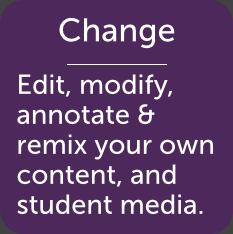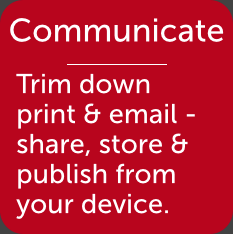I swore I’d never do it.
I swore I’d never unleash a quaint little memory device to simplify a process that otherwise demands a decent serving of your attention. But here we are, and truth be told, I’m pretty comfy with it.
Let’s talk purpose. My job is professional development, my philosophy under that is to build sustainability & adaptability, and we joke with schools that we’d love to get them to a point at which they wouldn’t need us anymore. So for me, the best way to do that is to help build up educators as independent, creative media-wranglers, be it from the room around them, the web, a colleague, or simply something interesting that’s happening nearby.
This bottled down to 5 core verbs. I like bringing the conversation back to verbs when talking about Learning Technology, because it makes the river rapids of new technology developments slow right down to a gentle meander. My 5 verbs to have under control are to Curate, Capture, Create, Change, and Communicate. Nail those five, mix them up, and you can do anything. There’s heaps of room to move within each, but they’re all forward-leaning and productive, rather than passive and consumption-driven.
Everyone needs a bookshelf. You’ve collected some things on your shelves from your work & travels. Some things you’ve made yourself. The point is that you’ve got a system, you know what goes where, what each item’s back story is, and how you can grab it quickly when it comes up in conversation.
In my digital environment, it’s tools like Dropbox, Google Drive, and most recently Copy that fit this space when I’m talking about things I own. It’s Diigo for my own professional reading and bitly for things I’m definitely collating to share if we’re talking about resources created & published by others.
A picture paints a thousand words. A recording makes those thousand words more expressive. A video tells an entire story. I carry devices with me at all times that can capture the world around me at near-professional quality. If I’m being deliberate about it, I can bring in professional-grade equipment to snap, record, or shoot the things going on in front of me that help me capture the story I need to tell.
This is 95% artistic, and 5% technical.
I shoot images with my camera. I capture audio in Evernote, or in a simple voice recorder. I shoot video either with my simple camera function, or I’ll use my fave recent find, Spark Camera.
If I wait for someone else to create exactly what I need because “I need training before I can do anything like that,” I’ll actually never lay my hands on exactly the materials and media that I want or need. If I acknowledge that my early works might end up a little bit rough around the edges, but I focus on the creation rather than the technical skills, I’ll work towards a really robust & flexible skill set.
My go-to is Keynote. I don’t think about it in terms of what it is. I think about it in terms of what it does. To me, it’s not a slideshow app. It’s a tool that displays, moves, and plays images, shapes, text & media on a screen. My focus on verbs turns it into a graphics editor, publishing tool, animation suite, notetaker, and video production studio. I use other things as well, but my biggest bang for buck has come from focusing on this one simple but flexible tool.
Sometimes people make things that are almost what I’m after.
Sometimes they’re happy to share. If that’s the case, I can modify it into exactly what I need, and give them some credit.
Sometimes I get things from other people that I need to annotate for feedback.
Chop, change, edit, annotate, remix. Sometimes it’s visual, and I’ll turn to graphics tools. Sometimes it’s text, and I’ll turn to text or annotation tools. Sometimes it’s media, and I’ll go to video tools.
There’s no hard & fast list here – this is where I have to work with what I find and problem-solve the best way to work with it.
Education is communication. If you’re a shabby communicator, you’re probably an excruciating teacher.
These days, that reaches a lot further. Today’s students, through the culture that surrounds them (not innate technological superpowers as some folks would have us believe) expect to be able to rummage & playlist-jockey the materials that pique their interest on demand. A linear, non-transparent approach to informational materials doesn’t fit with this. Or if you’re going to be linear & secretive, be creative & engaging about how you do it. Make it blazingly apparent why you’re holding on to some details until later.
Know how to share what you have. Not just technically, but ethically. If you’re sharing something of yours, be happy to see it used. If you’re sharing something you’ve found, tip your hat in the right direction. I use my blog (not nearly enough, but I’m working on it) and Twitter.
I hope this is useful for you. I hope you can use this to reflect on your own use of technology in your everyday life and work, and I hope it helps to fuel some interesting conversations with your friends & colleagues. Speaking of conversation, the comments section is right here, and I’d love to hear what you’re using in any and all of these categories, or if you’d modify these 5 headings in any way. That’s what the fourth one’s for, after all.











Leave A Comment